Comments
-
Philosophy Joke of the Day
I heard mine about 40 years ago. Your version must be much younger? -
Optics: Some Problematic ConceptsWhere is Poisson when you need him?
Poisson, an ardent supporter of Newton's corpuscular theory, had calculated that Fresnel's theory implied that there should be a bright spot at the center of the shadow of a circular object. That, he thought, was ridiculous and proved that Fresnel's analysis was wrong. Arago is supposed to have proven that it was indeed the case.
I could not find any article or fragment by Arago in which he talks of such an experiment. If you know of one, please let me know.
I have taken pictures with a pinhole lens and extension rings, as I have said in another thread. I noticed that the exposure time needed to be longer the more rings I used, that is the longer the focal length became.
I find it very strange for two reasons.
1) The same center of the scene keeps being projected, and should therefore be unaffected by the narrower field of view. Certainly for distant parts of the image.
2) Center rays, those going through the center of the pinhole and the rings in this case, should be completely unaffected by the length of the extension rings. They are after all on a direct and free path to the camera sensor.
This should mean that whatever the aperture, the center of the image should remain as bright, or at least brighter than the rest.
We should always have a Spot of Poisson on every picture ever taken by a camera at small apertures, or every image projected on a wall through a pinhole.
I will be grateful to whomever shall explain to me why that is not the case. -
Philosophy Joke of the DayPatient in a mental asylum climbs up a ladder workers have left against the garden wall. He sees somebody walking down the street and hails him:
"hey! Are there many of you in there?" -
Invisible Light and Unhearable Sound?As I understand it, a true man or woman of science would not be offended by this kind of skepticism. So I hope you are not. — t0m
I pulled the door ajar to this snake pit, so I should not be surprised if somebody pulled it all open.
Here is what I have to say in a nutshell.
1) I do not share the metaphysical premises of Relativity and Quantum Theory.
Call it metaphysical prejudice.
2) I believe many of the proofs are in fact circular: they assume that which they are supposed to prove.
I will not try to prove it nor do I expect you to take my word for it.
Call it logical prejudice.
3) I do not deny the progress made in Physics since the 19 century, and certainly do not deny the contributions of scientists like Einstein or Bohr.
This is not so much a defense of my position regarding Relativity and Quantum Theory, as a simple indication of where I stand, whether my positions are justified or not.
I would be thrilled if instead of constantly getting general objections in which I have to tackle all of Science, which is certainly not my intent (I believe in science I just do not take scientists at their word), people looked at my attempts to raise the discussion of the basis on which contemporary Physics rests, the theory of light, above the level of generalities.
I have attempted in my other threads to circumscribe the issues as clearly as possible, and presented empirical objections to central tenets of the dual theory of light.
I find it regrettable that none of the people who were so eager to defend this theory has ever indicated in which way my attempts were flawed.
And no, I do not feel offended. In fact, I hope you will turn out to be up to the task in exposing the fallacies in my threads by something more than proofs of blind loyalty to the phase physical science is now in.
Just remember, Ptolemy was one of the greatest astronomers of Antiquity, if not the greatest. In the end, all his complex models and computations turned out to be wrong. So please do not talk to me of the achievements of Quantum and Relativity as something that proves once and for all that these theories are correct, and not at least susceptible to amelioration, if not simply replacement by better theories.
Every generation of scientists, and certainly physicists, is convinced that the level they have attained is the maximum that can be reached.
Just imagine what scientists of the 30th century will think of "our" pretensions.
I apologize for bringing up Relativity and Quantum at all. -
Philosophy Joke of the Day
yeah, I know what you mean. Maybe it should go like this:
Camus: to be is to do.
Sartre: to do is to be
Sinatra: do be do be do -
Invisible Light and Unhearable Sound?
good answer. I don't feel like going into that snake pit either. -
Invisible Light and Unhearable Sound?
Yes, that is certainly a real danger. The problem is that scientists are usually worse philosophers than philosophers are bad scientists.
That's what makes you believe in fairy tales like Relativity and Quantum Theories. :) -
The Double Slit ExperimentA Real Life Approach (2)
There is something very interesting in the preceding, but also in the following images. Objects seem to react differently from light beams.
Look at how the laser beam is apparently reproduced over and over again.
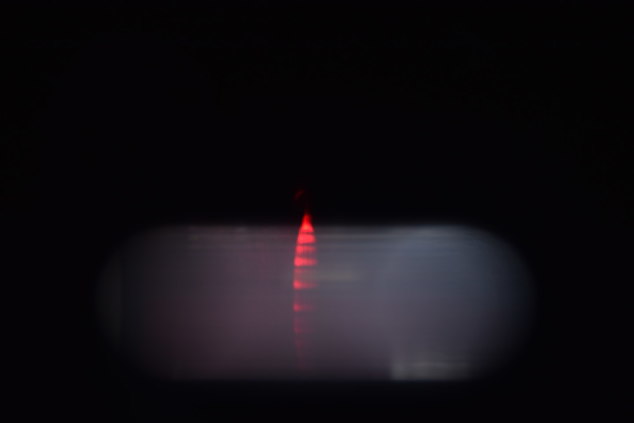
The books, on the other hand, are shown only once. The board dividing the two shelves, and which should probably be hidden by the space between the slits, seems to be projected two or three times.
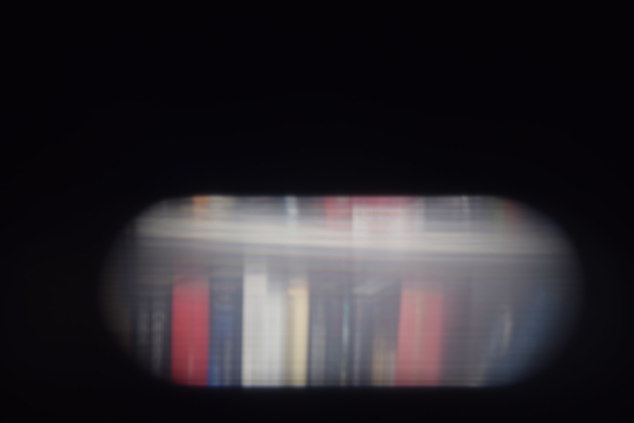
What I think is happening is that the laser beam, just like the books, also is reproduced but once. With maybe unsharp features here or there because of the divide.
I will certainly not claim of being able to explain all the features present in those images. -
Invisible Light and Unhearable Sound?
Of course, if it were merely a technical question. But then, how would scientists make the distinction between those "sound" waves and other kinds of phenomena? Like gravitational waves for instance.
The metaphysics of space is never very far away, and that is something that concerns philosophers also. -
The Double Slit ExperimentA Real Life Approach
Double slit experiments are usually presented in a very abstract manner. The light source must be monochromatic, and it is at the same time the sole object present in the experiment.
I present here pictures taken with a zoom lens, the first one free, and then with the same double slit slide I used before, taped to the lens, directly on a UV filter to avoid damaging the pricey glass.
The first pictures show in fact a double image which may be confusing. I could have just covered the letters on the slide (I think they represent the width of the slits, 0.013, but I am not quite sure), like I did for the last slides.
Notice that instead of interference patterns that always seem to be present when slits (single, double or multiple) are used, what we see is a picture, rather unsharp, representing a very recognizable part of the scene first taken with the uncovered zoom lens.
There doe not seem to be any mysterious or magical processes behind the obtained results. They are what we would see it we could look through the slits with our own eyes.
Unhindered view of one of my bookshelves. f/5.6, 1/20s, @ 92mm and ISO 100
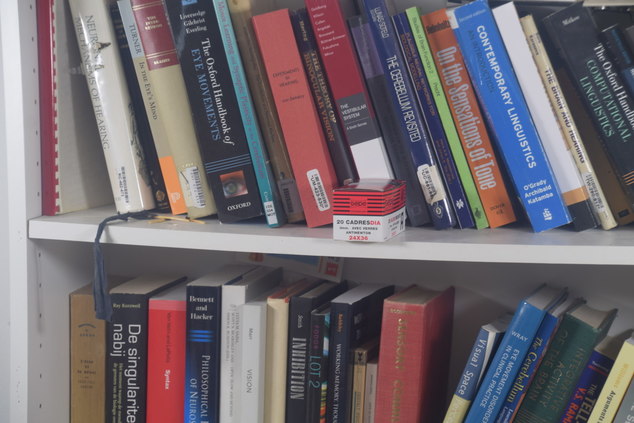
The circle represents the text on the slide. Notice that the space between the slits does not appear on the image at all. Such a phenomenon was one of the main reasons Newton's corpuscular theory was abandoned. Exposure time 15seconds.
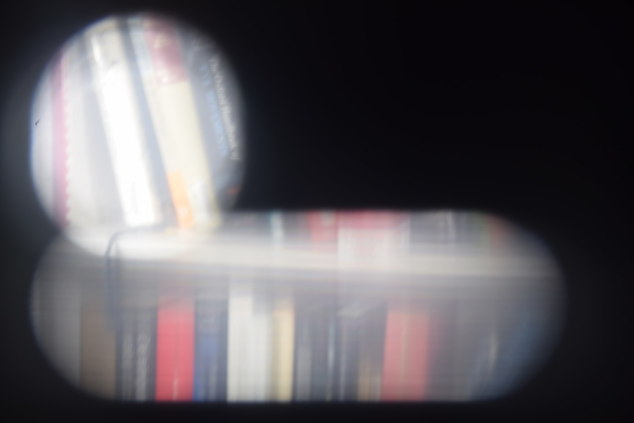
The circle has been covered by dark tape. 10 seconds.
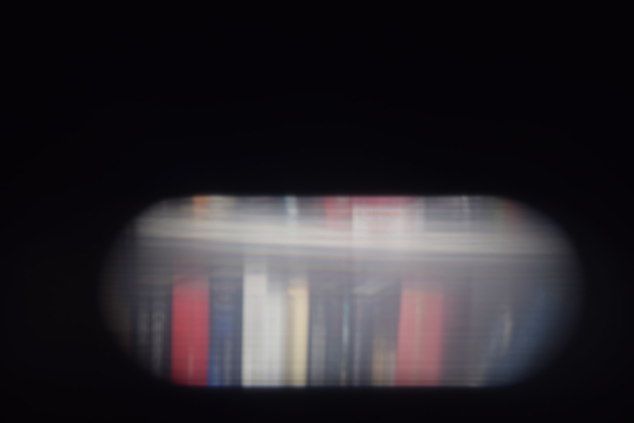
even under relatively very short exposure times, the whole scene
is still visible. 1/3 of a second.
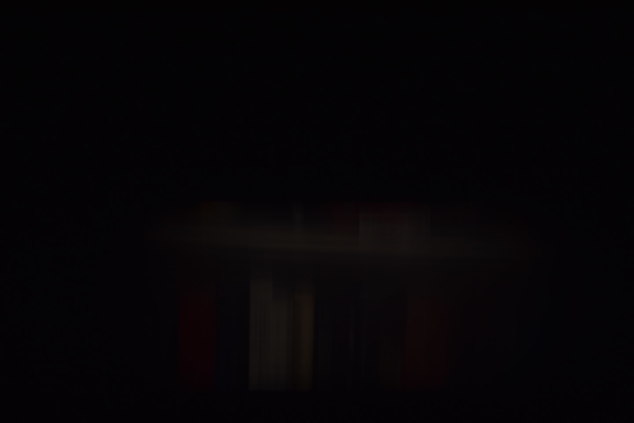
-
Invisible Light and Unhearable Sound?
I do not mean sound specifically. I assume that we would not hear anything.
But would something like the LIGO detector notice anything going on in space? Like the LIGO detector, I have no idea whether it would react or not. -
Invisible Light and Unhearable Sound?
The point is that two objects collide in space where there is no medium to propagate sound waves to our ears. Maybe your are right, and only heat and light would be produced in space. I was just wondering, since the last Nobel Prize was awarded to gravitational waves, whether that is all that is present in space.
A silent Big Bang? Maybe be. But there is also something like background radiation, or "noise", or whatsoever.
As I said, I have really no idea. -
The Double Slit ExperimentWave length, Distance and Interference
The principle of interference, and wave length, depends on the actual distance a wave or a ray is supposed to travel between two points.
A simple way of altering the distance between two points is to rotate the screen slightly around its vertical axis. This way, some distances would become (slightly) shorter, while others would become longer.
By subtly changing the position of the screen, one should therefore be able to transform a dark ring in a bright one, and vice versa.
Shaoul Ezekiel seems to be doing just that. Except that his setup is much more complex and involves mirrors, lenses and beam splitters.
The setup with a light source and a screen is much simpler and easier to interpret: does distance play a role in the formation of dark and bright rings?
I invite you to see it for yourself. I cannot show it to you because it would need more a video feed than still images, but I personally could not detect any effect.
Please do not take me at my word! -
The Double Slit ExperimentVertical Slice
I have used a simple application any Windows user have at his/her disposition, Paint. What I have done is take one of the pictures of the rings formed by a laser beam om the camera sensor, and deleted everything but a very thin slice.
I hope to show that the so called double split patterns of constructive and destructive interference are nothing but the original image seen through very narrow slits.
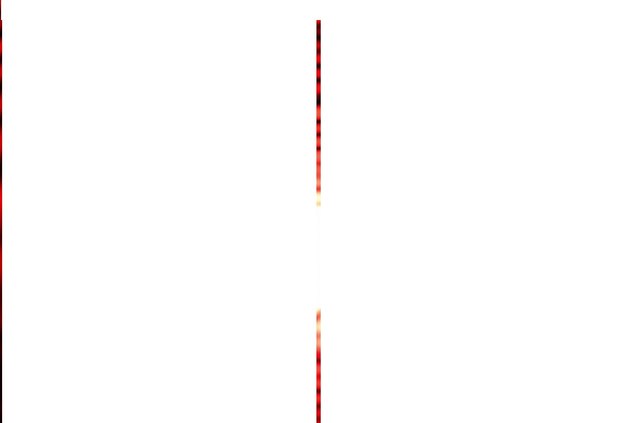
-
The Double Slit ExperimentFinally! The Real Double Slit Experiment!
I am sorry it took so long, but I just got the slide in the mail this afternoon. It concerns a slide (50mm/50mm) with two slits of 0,013 mm each, separated by a distance, from center to center, of 0,1 mm.
As usual, I taped the slide to the body cap of a digital camera. The cap was almost completely open, having kept only the outer periphery to attach it to the camera body.
I will let you draw your own conclusions but it seems to me that what we are dealing with is simply a slice of the image we got when nothing was impeding the laser beam on its way to the camera.
In other words, the concepts of constructive and destructive interference are completely superfluous!
1/4000s
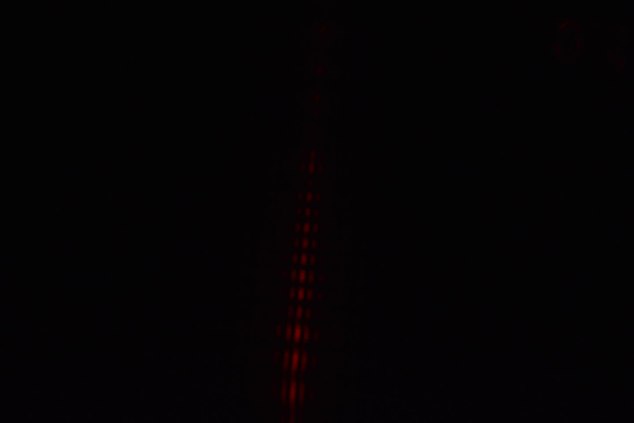
1/2000s
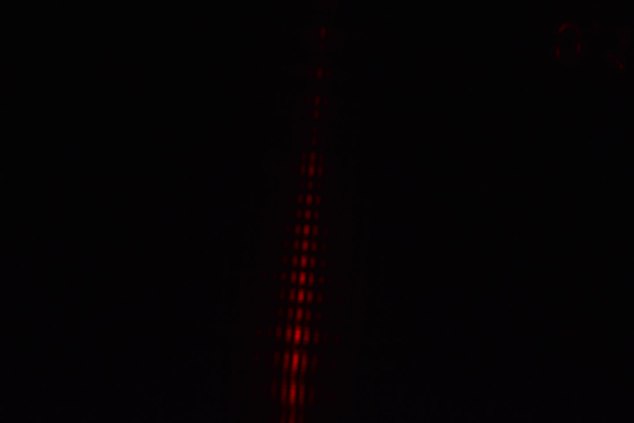
1/1000s
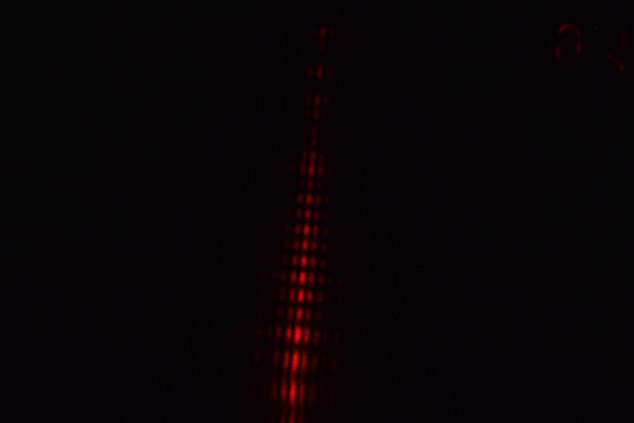
1/200s
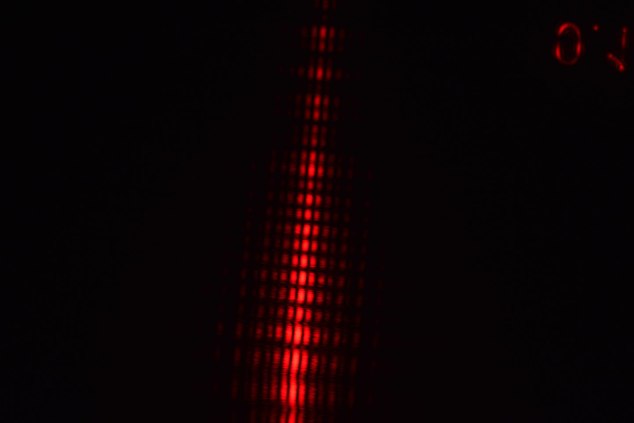
1/60s
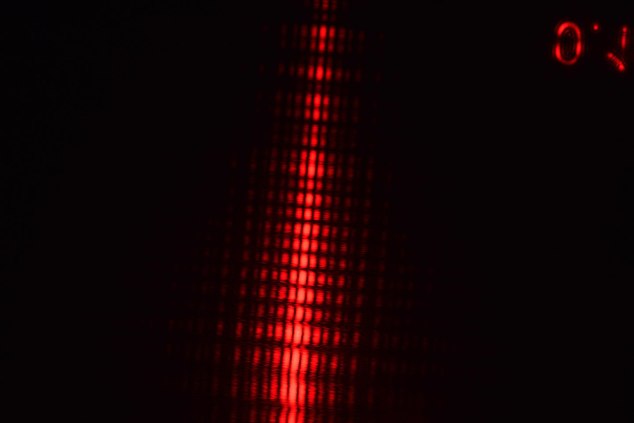
1/15s

1 second.
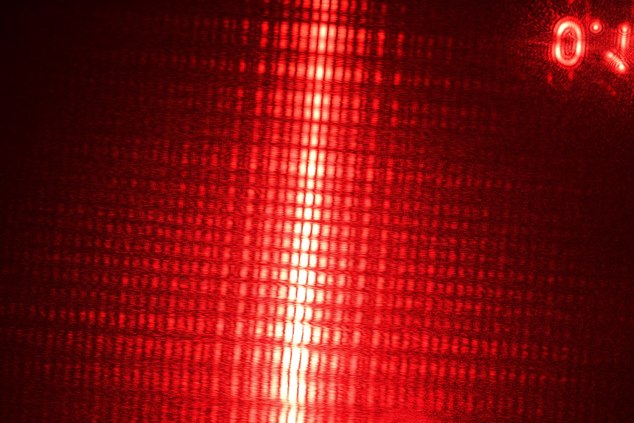
3 seconds
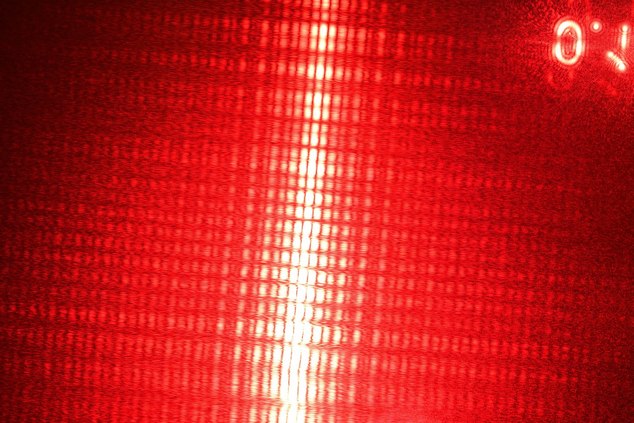
The partial text on the upper right corner are some markings on the slide and irrelevant to the double slit experiment. -
Open and Free discussion?I think it is good practice for philosophers to learn to deal respectfully with people with whom they disagree on fundamental issues. As I said, my only problem is that I worry that the forum will be hijacked and it's nature changed significantly. — T Clark
I couldn't agree with you more. But you should do something about it if you really believe that the forum is in any danger of being perverted. -
Open and Free discussion?Actually, I have no problem with you presenting your ideas here, but I worry that others may join you and the forum will lose it's direction. — T Clark
I am curious as to how you intend to counter my malevolent influence. -
Open and Free discussion?
I would be, to name but a few themes, very interested in your views about the double slit effect, interference and Newton rings.
I am not inviting you to participate in my threads. I think it would be quite a sterile dialogue. But you are of course free to quote me and criticize me in your own threads. And I would do the same in mine.
The advantage of such a construction is that we both would have the freedom to pursue our own line of thought, and only react to others when we deem fit.
It would also be much less confusing for members who are not really into Physics.
By the way, I do not see this as a competition, but simply as a sharpening of the arguments on both sides. -
Open and Free discussion?
I suggest you open threads where you disassemble "wrong" ideas about scientific issues. That would be a positive contribution to this forum, much more than trying to ban people with whom you do not agree. -
Open and Free discussion?
I think T Clark, that you belong with the so-called philosophers of the middle ages that considered everything that Aristotle said a word of truth. May I remind you that in science, and I am neither creationist nor flat-earther, a theory is only considered true until it is "proven" false. The ether was considered a scientific concept for more than three hundred years.
Considering sound, you should read my threads more carefully. Sound as a sensation is impossible in empty space because it needs a medium, not necessarily to propagate, but to affect our hearing.
What I was talking about was the biological component of sound.
At the same time, sound can be considered, just as light, as an electromagnetic wave. And just as light, it would not be surprising if it could cross distances of empty space. We would not hear the effects of a nova, but that does not mean that the "noise" is not reverberating through space.
It is therefore not as simple as you would like it to be.
Unless you have an explanation for how certain electromagnetic waves can travel through empty space, while others cannot.
I was therefore using "sound" as physicists use "light", whether we can perceive it or not.
By the way T Clark , this is the third time that you attacked me personally, and I really wonder what your problem is. -
Optics: Some Problematic ConceptsDistance, Object Size and Light
I have already discussed of the singular fact that objects become smaller with distance. For that I got treated to an elementary lesson in Optics and spatial perspective, as if that were an explanation in itself.
Here is a puzzle.
When an object is distant we assume that the light rays it propagates become somehow parallel. Just like waves when they are infinitely stretched.
This is a central assumption of Optics. How well is it justified?
We will all agree that the object in the distance has not somehow shrunk to its visible proportions, and we do not doubt an instant that if we were to approach it, it would regain its true size.
Imagine alien observers looking at our Sun from a few hundreds or thousands of light years away. It would appear to them as very small of course.
Think now of the light rays emanating in their direction. How could they ever become parallel with the distance? And if they did, wouldn't that mean that the alien observers would in fact be incapable of even detecting the sun since only a small portion of the parallel rays would be captured by their telescope?
But now that you think of it, if the light rays do not become parallel, how would it be possible at all for these observers to see our Sun? Since the sun is radiating rays in all directions, and these rays, just like Faraday's electromagnetic lines of force, would keep diverging from one another, weakening the light of the sun until it disappears entirely, there will come a moment where the distance between each (invisible) ray would become so great that the largest telescope would not be enough to gather them through the same lens.
No, apparently, the only way for the Aliens to see our Sun would be if our fiery star did shrink with the distance. Only this way could its rays become parallel and enter the alien telescope. -
Optics: Some Problematic ConceptsLight Rays, Objects and Vision
Have you ever thought about the fact that we are able to take a picture of the sun, the ultimate source of light?
For that we have to neutralize the light rays overwhelming our sensors.
But what does it mean that we can see behind the light rays?
Light theory would make us believe that it is those rays, that make our cameras and eyes blink, that carry the image of the sun to us. But which rays are we talking about? And is it really just a matter of intensity?
Let us suppose that it is indeed a matter of how strong the light is. If it is too strong, all we see is the light itself.
Remember the burning glass trick? Focus a magnifier in such a way that it can burn through a sheet of paper? But what if you do not want to burn the paper, and aim at projecting an image of the sun instead?
Very simple, you make sure that the rays are (slightly) out of focus on the paper. As we all know, an image of a distant object will appear after the focal point, and will be inverted, its size depending on the focal length of the objective.
Think about that. What is then forming the image if all rays are made by the lens to converge on a focal point? After all, they start diverging right after that until they are too far from each other to be perceived as an image.
Ray tracing glosses magnificently on this annoying fact. It makes us draw lines from the object to the image, but those lines are imaginary lines, while the only lines we can see and make visible are the rays captured by the lens and made to converge or diverge.
Ray tracing is in fact tracing an alternate reality. The image can appear anywhere after the focal point and that makes it very difficult to define what exactly is a focus.
Ray tracing tells us that a point i on the image is in focus when all the rays emanating from a point o on the object converge to i.
But where are those rays, and how come we cannot see them? How come we can see all the light rays converging, or diverging, through a lens, but not the ray tracing rays?
Ray tracing rays, just like light waves, are mathematical constructs that make it possible for us to build a rational image of the visual world, but it would be very difficult, if not impossible, to prove their empirical existence.
All of this simply means that we do not know how images are formed, even if we have a very rational explanation for it. This explanation remains a geometrical fiction, however useful it may be.
Of course, something does not need to be visible to exist. After all, who in this century would dare deny the existence of atoms and sub-particles?
But we are talking about light, something very tangible, and only meaningful, as far as images are concerned, when it can be made visible.
What are light rays, or waves, that are only visible to the mathematician? -
The Double Slit ExperimentWhite Light and Interference (2)
This is how the same picture looks like when a red (dark orange) filter is placed in front of the torch.
Except for the color, nothing is changed as far as I can see.
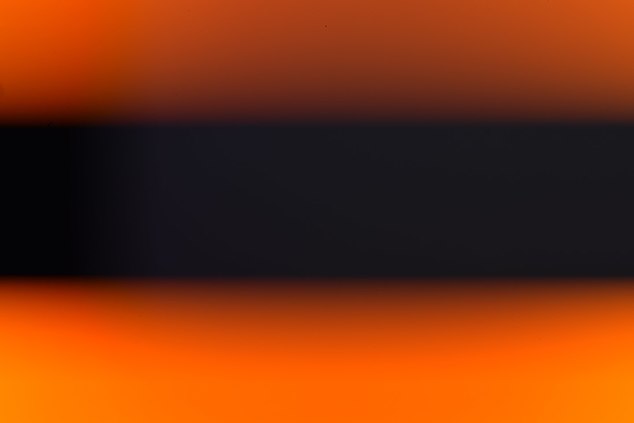
This reinforces me in my conviction that what we consider as properties of light are most often simply the properties of the light source. -
The Double Slit ExperimentWhite Light and Interference
I find the following picture quite intriguing, especially when you consider how the camera reacted. Instead of a laser pen I used a flash light and directed the beam, as before, through the opening of the camera body. When I looked at the Lcd screen I saw white and black bands scrolling down, in a regular fashion.
Imagine black bands like this one being alternated with white ones. It was taken with 1/1000s.
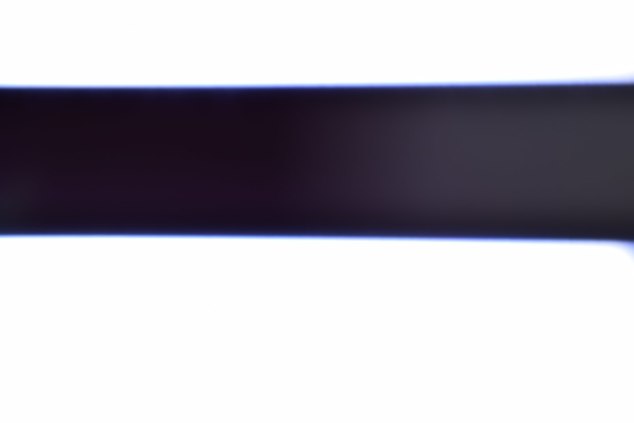
I found the scrolling very peculiar and have no explanation for it.
In fact I was trying to show the pattern my electric torch left on the wall, or a screen. A rectangular pattern of bright and dark bands. Maybe this image is just a part of it.
Anyway, I think that, just like when taking a picture of the sun, we have to adjust our exposure speed to get the sun in the picture, instead of an all encompassing white blob.
What we are seeing each time are not the light rays, but the structure behind them. -
The Double Slit ExperimentInterference and Newton Rings (2): double anti-Newton glass
Since Newton rings are always presented as being the result of at least two surfaces pressed against each other, creating minuscule differences in the distances between one surface and the other, and therefore creating the rings of constructive and destructive interference, I wondered what would happen if I used both glasses of the slide, and not only one. Would the rings disappear entirely?
Apparently not.
The first picture has been taken at 1/4000s, and the second at 1/320s. The rings are definitely less pronounced as before, but still there. Would better quality glass eliminate the rings completely?
But why are they present in the first place when only one glass is used?
Again, a puzzle for whomever believes in interference phenomena.
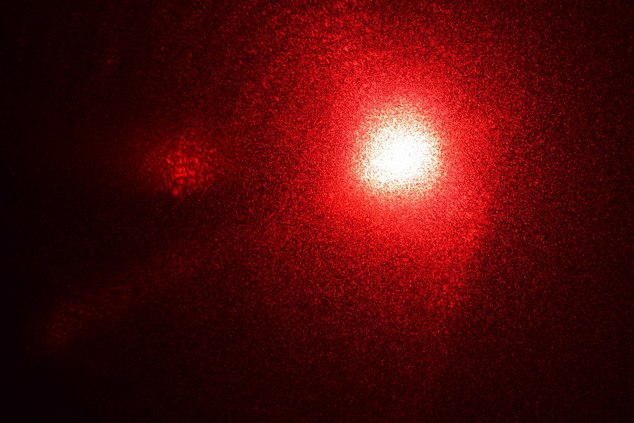
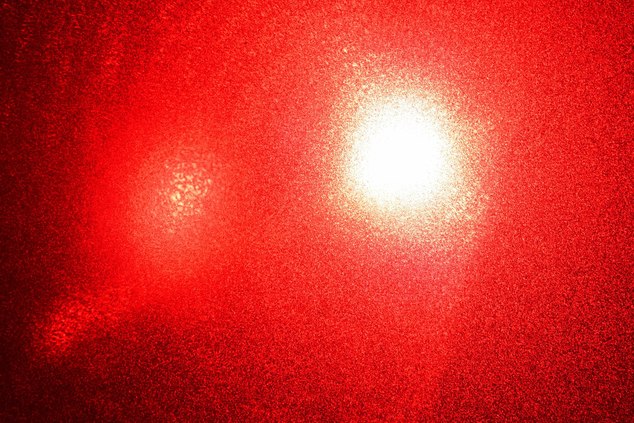
-
The Double Slit ExperimentInterference and Newton Rings
Allow me to start with an image already displayed, an open camera body, no lens, and a laser pen directed at the center, more or less, of the mirror.
The first picture has been taken at 1/400s. All images were set at ISO 100.

You will notice the bright and dark circles that appear in all experiments where interference phenomena are said to be studied.
This picture has been taken, allow me to emphasize this fundamental fact, with nothing between the camera and the laser beam. Since the mirror is drawn up at the moment of exposure, these rings have to come either from the pen itself, the sensor diodes, or both.
The following pictures have been taken with an Anti Newton glass, one part of a slide frame, taped to a body cap on which a hole with a diameter of approximately one centimeter had been drilled. Notice that the so-called Newton rings are still present, but only visible at short exposures
At 1s, no rings are visible.

At 1/1000s, the rings are clearly visible.
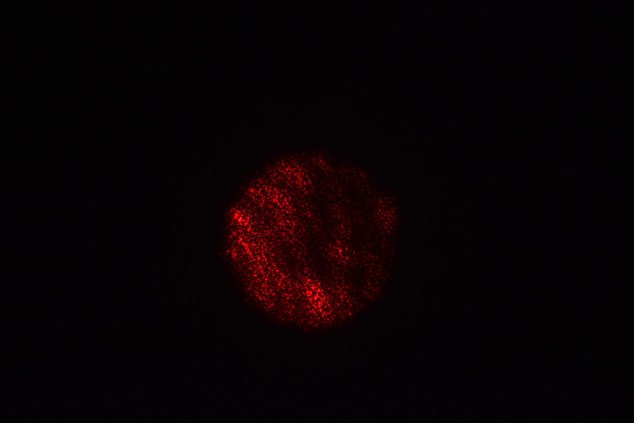
The following picture has been taken again with an anti Newton glass taped to a body cap, but this time I had made the opening much larger to avoid any misunderstandings concerning diffraction phenomena.
The lower dark half is an artifact due to misalignment of the slide. The exposure time was 1/4000s.

I thought these pictures might be interesting for people familiar with the phenomena of constructive and destructive interference, as well as with the so-called Newton rings. I wonder what they make out of it. -
Open and Free discussion?
Thank you for the tip. I will try and put it into practice all the time. -
The Nobel Prize of Physics 2017A Youtube clip, and there are many, shows how much the use of an interferometer depends on the beliefs of the observer. It is like pointing at a Santa in a mall to prove the existence of the mythical figure.
-
The Double Slit ExperimentPlease understand my reaction. I consider my threads as a work in progress, but only if I can find my own posts back and relevant comments and objections. I have no interest in rehashing subjects that have already been chewed to death.
-
The Double Slit ExperimentMaybe you guys could start a thread about probability and determinism. It won't be the first, and it doesn't need to be the last.
-
The Double Slit Experiment
Please remember that this thread is about a light phenomenon, and not about consciousness. That would also be my plea to Rich, not to drown this thread in more general issues, however exciting they may be. -
The Double Slit Experiment
I would be inclined to agree with you with the following distinction: there is nothing probabilistic about material processes, only about our knowledge of them and how we react to them. -
The Double Slit Experiment
Let us say that, if there is something like a photon, I am convinced it goes either through one slit or the other.
https://philpapers.org/post/23274 -
The Double Slit Experiment
I am afraid I do not share the metaphysics of the Copenhagen school. I do not believe the particle is in anyway affected by mere observation, and I certainly do not believe that it can go through two slits at the same time. This is only considered as possible because of the theory of the dual nature of light.
That is what I am trying, painstakingly, bit by bit, not to prove, that is I think impossible, but to at least show as plausible.
This is at the same time an answer to szardosszemagad. -
The Nobel Prize of Physics 2017
Agreed. There is always a matter of interpretation. The question is whether the phenomenon in question is defined by the instrument or the other way around.
Bergson did not think that clocks could measure "duration", but even he had to acknowledge the existence of what he called spatial time.
The same way, nobody denies the conventionality of units of weight or distance, and even if there might be some confusion among laymen about the distinction between weight and mass, everybody knows what it is, and the idea of weighing or measuring something is as empirical as can be.
Measuring sticks cannot therefore be said to define that which they measure, but to present a practical way of dealing with them and manipulating them.
The idea behind interferometers is that, as you imply, it is exactly the same as with other instruments.
There is a big difference though.
Interferometers do not need to define light, we all know what it is. Just as scales do not need to define weight or distance. But interferometers still go much further than scales. They define fundamental properties of light. They tell us that light can go through two different paths at the same time, and also that its waves can reinforce or destruct each other. They show us some light patterns and ask us to believe that this is what is happening.
Interferometers are in this sense much more complex than scales. They are a theory in themselves.
https://philpapers.org/post/24298
https://philpapers.org/post/25490 [see also the rest of the thread]
Hachem

Start FollowingSend a Message
- Other sites we like
- Social media
- Terms of Service
- Sign In
- Created with PlushForums
- © 2025 The Philosophy Forum






















